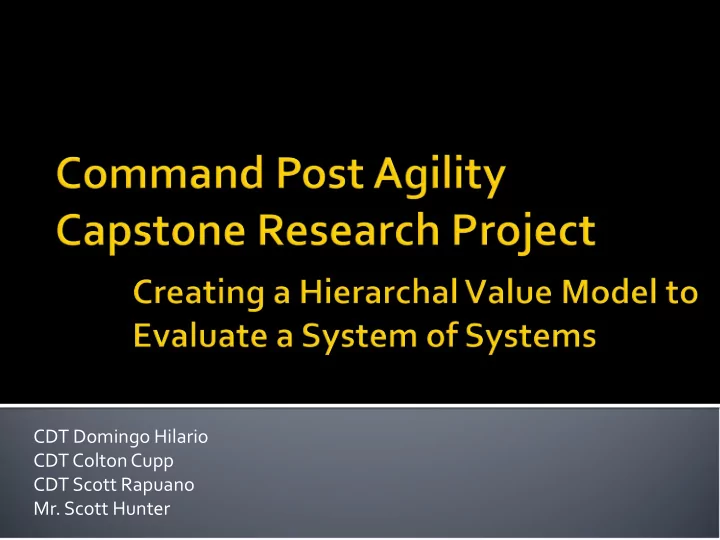

CDT Domingo Hilario CDT Colton Cupp CDT Scott Rapuano Mr. Scott Hunter
The Team Stakeholders Background (Command Post Context and History) Problem Statement and Answer Value Modeling with Example The Hierarchal Value Model Concept of the Model Base Level Analysis Intermediate Level Analysis Whole System Analysis Conclusion Recommendation Tool Demo Questions
Primary Customer TRAC-WSMR is in charge on planning, organizing, and conducting bi- annual Network Integration Exercises (NIE) in order to put together reports which entail the effects of different incremental enhancements on the different command post Other Stakeholders Brigade Modernization Command The Modernization Brigade at Ft. Bliss has a TRAC-WSMR detach element in charge of testing and evaluating technology enhancements for Command Post systems US Combined Arms Center and Mission Command Center of Excellence Focused on providing the vision and direction of how Command Posts shall be in the future. They are in charge of researching and analyzing technological enhancements which will accomplish a set of goals in making command post more agile, effective, and efficient
“As the size, complexity, mobility, and dispersion of military forces increased, the challenges of obtaining and disseminating information and of maintaining control increased as well. Expanded staffs, improved organization and procedures, and new technology…could alleviate some of these difficulties, but they created new problems for commanders to solve.” --David W. Hogan, Jr. “ A Command Post at War”
Provide a systems engineering framework to be able to evaluate the whole system (Command Post) and its many subsystems (e.g., structures, visual information, power, etc.) while maintaining flexibility for the many stakeholders
We have constructed a hierarchical value model (in MS Excel) to evaluate focus area (or subsystem) improvements of a CP and CP configurations The hierarchical value model provides a ranking of CP improvements, sensitivity analyses, and Pareto charts to further aid in making informed decisions
Why decisions are hard: • Multiple objectives • Multiple stakeholders (opinions) • Uncertainty A value model is a multi-objective decision analysis tool It is based on weighting the multiple objectives to give them a relative importance to each other
There are common objectives for any CP that were given. These are: Set-Up time/ Agility Energy informed operation Complexity Mobility Integration Size Scalability Additionally there are objectives for each subsystem, say a visual display: Lumens/brightness
The first step is to give a common value scale and provide a value curve for each objective
The next step is provide the actual performance for each objective for each alternative and then the value score is calculated
Now assign each objective a weight
Then calculate a relative weight
Finally each objective’s value is multiplied by its weight and summed to provide an overall total value score = ∑ n ( ) ( ) v x w v x i i i = i 1 This is done for each alternative and the values can be compared numerically and graphically
"Visual" Alternative Comparison 10.0 9.0 Maximize visibility 8.0 Minimize size 7.0 V 6.0 Maximize integration a Maximize scalability 5.0 l u 4.0 Minimize system complexity / clutter e 3.0 Maximize mobility 2.0 Minimize time of setup / agility 1.0 Maximize energy-informed operations 0.0 TV (original) Projector Smartboard
Sensitivity of Lumens 8.0 7.0 6.0 5.0 TV (original) 7.5 4.0 Projector 6.3 3.0 Smartboard 5.6 2.0 1.0 0.0 0 20 40 60 80 100
Value models provide a way to compare alternatives with multiple objectives However, with Command Posts there are many competing subsystems The Hierarchal Value Model uses a tiered value model approach from the smallest sub- system to the whole system
Whole System Intermediate Subsystem Base Level Subsystem
Focus Areas Displays, Tables, Chairs, Network, ECU, Power Generation, Power Distribution “Big 7” Objectives Set-Up time/ Agility, Energy informed operations, Complexity, Mobility, Integration, Size , Scalability
The intermediate subsystem would be a tent structure A comparison can be made using different combinati0ns of the subsystems The same process occurs and weights are applied to importance of each subsystem How important is each component to accomplishing the CP's mission? Weights Visual 35 10% Power Distribution 80 24% Power Generation 40 12% ECU 65 19% Network 45 13% Furniture- Chairs 30 9% Furniture- Tables 40 12%
Airbeam Layout Comparison 8 7 6 Furniture- Tables 5 Furniture- Chairs Network 4 ECU Power Generation 3 Power Distribution Visual 2 1 0 Original CP Max CP Custom CP1 Custom CP2 Custom CP3
Energy Consumption (Max) 200 100% 180 90% 160 80% 140 70% 120 60% Watts 50% 100 80 40% Raw Score 60 30% 40 20% % Contribution 20 10% 0 0%
Subject matter experts propose alternative Command Post configurations based upon mission requirements and intelligence Weights are again assigned to the “Big 7” Main difference is that total value score takes into account the number of intermediate subsystems A value bar chart is again produced and a winner can be determined
CP Layout Comparison 7.30 7.20 7.10 Custom CP 1 7.00 Custom CP 2 Custom CP 3 6.90 6.80 6.70 Custom CP 1 Custom CP 2 Custom CP 3
Value modeling is an effective way to evaluate multiple objective decisions The hierarchal value model approach ties the analysis together from subsystems to the whole system The hierarchal model allows flexibility for changes in circumstances We believe this tool does a pretty good job at answering the call for all stakeholders
Serious thought needs to go into determining the weights Update the model with user feedback from testing exercises and field use
Recommend
More recommend